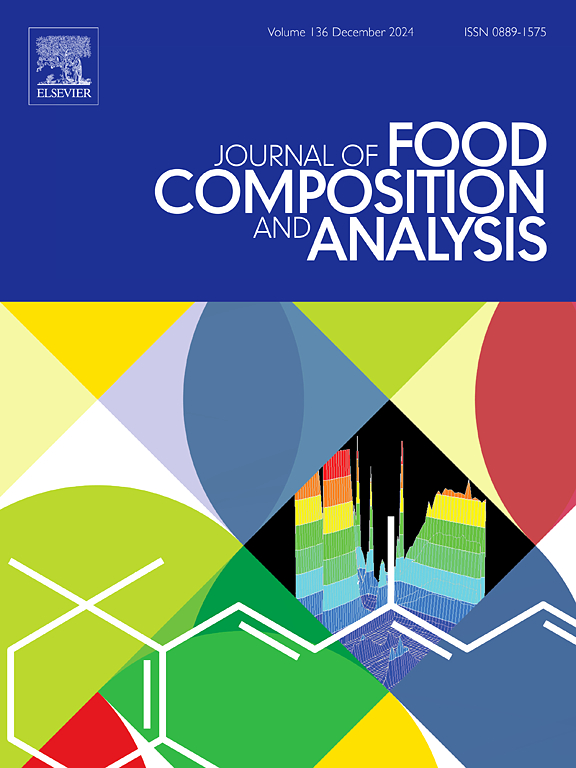Pesticide residues in wheat grains in Türkiye (2021–2024): Multi-year monitoring and health risk assessment
IF 4
2区 农林科学
Q2 CHEMISTRY, APPLIED
引用次数: 0
Abstract
This study presents a multi-year monitoring effort involving 984 wheat grain samples collected throughout Türkiye from 2021 to 2024, focusing on the detection of 324 pesticide residues and their associated health risks. The analytical methodology, based on QuEChERS extraction and LC-MS/MS analysis, was validated in accordance with SANTE/11312/2021 guidelines, demonstrating high accuracy and sensitivity. Detectable pesticide residues were found in 47 samples (4.77 %), of which 25 samples (2.54 %) exceeded the maximum residue limits (MRLs) established by the European Union. The identified residues included chlorpyrifos-ethyl, pirimiphos-methyl, imidacloprid, deltamethrin, acetamiprid, triasulfuron, triticonazole, pyraclostrobin, and thiamethoxam. Among these, chlorpyrifos-ethyl, imidacloprid, triasulfuron, and triticonazole exceeded their respective MRLs in at least one sample. Chlorpyrifos-ethyl was the most frequently detected pesticide, followed by pirimiphos-methyl and imidacloprid. Notably, chlorpyrifos-ethyl, banned in Türkiye since 2020, exceeded its MRL in all positive samples, suggesting either illegal use or environmental persistence in agricultural soils. Health risk assessment showed that both chronic (HQc) and acute (HQa) hazard quotients remained below 1 for all detected compounds, indicating no significant health risk to either adults or children. The presence of banned pesticides highlights the urgent need for more stringent regulatory enforcement and expanded residue surveillance to ensure food safety in staple crops and safeguard broader public health.
浙江省小麦籽粒农药残留(2021-2024):多年监测与健康风险评估
本研究提出了一项多年监测工作,涉及2021年至2024年在整个 rkiye收集的984个小麦谷物样本,重点检测324种农药残留及其相关的健康风险。分析方法基于QuEChERS提取和LC-MS/MS分析,根据SANTE/11312/2021指南进行验证,具有较高的准确性和灵敏度。47份样品(4.77 %)检测出农药残留,其中25份(2.54 %)超过欧盟规定的最大残留限量(MRLs)。残留包括乙基毒死蜱、甲基吡虫磷、吡虫啉、溴氰菊酯、啶虫脒、三硫脲、三唑康唑、嘧菌酯和噻虫嗪。其中,乙基毒死蜱、吡虫啉、三磺隆和三唑康唑至少有一个样品超过了各自的最大残留限量。乙基毒死蜱的检出率最高,其次是吡虫磷和吡虫啉。值得注意的是,自2020年以来在基耶蚊中禁用的毒死蜱-乙基毒死蜱在所有阳性样本中都超过了其最大残留限量,这表明要么是非法使用,要么是农业土壤中的环境持久性。健康风险评估显示,所有检测到的化合物的慢性(HQc)和急性(HQa)危害商数均低于1,表明对成人或儿童都没有重大健康风险。禁用农药的存在突出表明,迫切需要更严格的监管执法和扩大残留监测,以确保主要作物的食品安全,并保障更广泛的公众健康。
本文章由计算机程序翻译,如有差异,请以英文原文为准。
求助全文
约1分钟内获得全文
求助全文
来源期刊

Journal of Food Composition and Analysis
工程技术-食品科技
CiteScore
6.20
自引率
11.60%
发文量
601
审稿时长
53 days
期刊介绍:
The Journal of Food Composition and Analysis publishes manuscripts on scientific aspects of data on the chemical composition of human foods, with particular emphasis on actual data on composition of foods; analytical methods; studies on the manipulation, storage, distribution and use of food composition data; and studies on the statistics, use and distribution of such data and data systems. The Journal''s basis is nutrient composition, with increasing emphasis on bioactive non-nutrient and anti-nutrient components. Papers must provide sufficient description of the food samples, analytical methods, quality control procedures and statistical treatments of the data to permit the end users of the food composition data to evaluate the appropriateness of such data in their projects.
The Journal does not publish papers on: microbiological compounds; sensory quality; aromatics/volatiles in food and wine; essential oils; organoleptic characteristics of food; physical properties; or clinical papers and pharmacology-related papers.
 求助内容:
求助内容: 应助结果提醒方式:
应助结果提醒方式:


